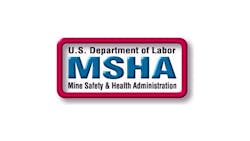MSHA Rule Requires Mine Operators to Sniff Out Violations of 9 Key Safety Standards
Every year, MSHA uncovers violations of the same nine health and safety standards in underground coal mines – violations that can have dire safety implications for workers. To address this problem and require underground coal mine operators to identify and correct these hazardous conditions, the agency’s final rule, “Examinations of Work Areas in Underground Coal Mines for Violations of Mandatory Health or Safety Standards,” went into effect Aug. 6.
After analyzing its accident reports and enforcement data for underground coal mines covering a 5-year period, MSHA found that the same types of violations of nine key standards emerge each year. The nine standards address ventilation, methane, roof control, combustible materials, rock dust, equipment guarding and other safeguards.
"These repeated violations expose miners to unnecessary safety and health risks that should be found and corrected by mine operators. The final rule ... will increase the identification and correction of unsafe conditions in mines earlier, removing many of the conditions that could lead to danger, and improve protection for miners in underground coal mines," said Main.
The rule requires that, during pre-shift, supplemental, on-shift and weekly examinations, underground coal mine operators, in addition to examining for hazardous conditions as in the existing regulations, examine for violations of the nine specific health and safety standards. The rule also requires operators to record the actions taken to correct hazardous conditions, as in the existing regulations, and violations of the nine standards. Additionally, operators must review with mine examiners, on a quarterly basis, citations and orders issued in areas where pre-shift, supplemental, on-shift and weekly examinations are required.
In 2011, MSHA issued approximately 158,000 violations, of which approximately 77,000 were attributable to underground coal mines, even though these mines represent just 4 percent of all mines.
This rule was published in the Federal Register April 6 and became effective Aug. 6.
About the Author

Laura Walter
Laura Walter was formerly senior editor of EHS Today. She is a subject matter expert in EHS compliance and government issues and has covered a variety of topics relating to occupational safety and health. Her writing has earned awards from the American Society of Business Publication Editors (ASBPE), the Trade Association Business Publications International (TABPI) and APEX Awards for Publication Excellence. Her debut novel, Body of Stars (Dutton) was published in 2021.

